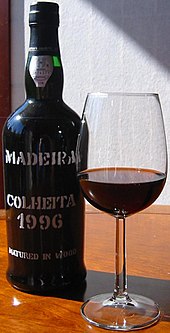Fortified wine

Liqueur wine (also fortified or fortified wine ) is a collective term for different wines whose fermentation process was interrupted by being fortified with alcohol ("fortified"). These wines are accordingly alcoholic and as sweet wine (dessert wine) usually have residual sweetness , but can also be expanded dry. Sometimes the term southern wine is also used synonymously , which in a very unspecific way means all wines that come from southern Europe and are fortified or have a high residual sugar content. Overall, the distinctions between liqueur wine and sweet wine or dessert wine are often imprecise and therefore misleading. There are no legal definitions or regulations in the EU for sweet wines and dessert wines. So z. For example, the non-fortified Italian Vin Santo , which has an alcohol content of around 16 percent, is sometimes mistakenly counted among liqueur wines in German, but is a sweet wine.
The definition for fortified wine is set out in EU regulation 1308/2013 of December 17, 2013. The potential alcohol content of the must to be fermented must be at least 12 % by volume , i.e. the must weight should be at least 84 degrees Oechsle . After the liqueur wine has matured, the alcohol content of the wine must be between 15 and max. 22% by volume. As alcohol additive, neutral alcohol from wine distillation with at least 96 percent by volume or distillates from wine such as brandy or pomace brandy with at least 52 and a maximum of 86 percent by volume may be used. Before the alcohol is added, the alcoholic fermentation must already have an alcohol content of at least four percent by volume.
Well-known fortified wines
- In France , the vin de liqueur or vin liquoreux or vin doux naturel called wines are grouped under the vins mutés family . Appellations in which the vins doux naturels are made are Banyuls , Rivesaltes , Muscat de Rivesaltes , Maury , Muscat de Beaumes-de-Venise , Muscat de Saint-Jean-de-Minervois , Muscat de Frontignan , Muscat de Mireval , Muscat de Lunel , Muscat du Cap Corse , Pineau des Charentes and Rasteau .
- In Spain the wines were grouped under the generic term of Vino generoso . All sherries , manzanillas , mistelas , some wines from Montilla-Moriles and the wines of the Málaga region are generosos.
- In Portugal these wines are called Vinho generoso . The Generosos from Madeira , Porto ( port wine ) and Setúbal ( Moscatel de Setúbal ) are the best known.
- In Italy 's Vino liquoroso very popular and is produced viticulture regions in nearly all. The Marsala is also a well-known fortified wine.
- Samos and Mavrodaphne are fortified wines from Greece .
history
The expansion of liqueur wines originated in southern European growing areas. The high must weights of the harvests there with comparatively high ambient temperatures during fermentation ensured a very stormy start of fermentation with the simultaneous risk of an uncontrolled stop of fermentation. This often resulted in a wine that could not be preserved. This was supported by the fact that the winemakers no longer mastered the preservative effect of sulfur dioxide , which was already known in ancient times. Without preservation, wines with high acidity, the so-called "vinegar tinge", were quickly created. The fortified wines are well suited for export. Port wine, Madeira or Marsala were shipped to northern European countries a few hundred years ago, as they were very durable due to the higher alcohol content.
The addition of neutral alcohol during fermentation ensured good preservation and also made it possible to control the residual sweetness by selecting the moment at which the alcohol was added. In California and Australia , the so-called fortified wines were still an important part of production in the 1960s. Best-selling products were liqueur wines with an alcohol content of up to 20% by volume, which were an inexpensive, tax-favored alternative to hard alcoholic beverages.
With modern cellar technology such as earlier harvest, cooling of the fermentation tanks and sulphurisation, the wine would actually be superfluous. As a result, a large number of products of inadequate quality have disappeared from the market and have been replaced by high-quality, modern wines. The Spanish region of Rueda is an example .
literature
- Roger Voss: Pocket Guide to Fortified and Dessert Wines . Mitchel Beazley, 1989, ISBN 978-0-85533-698-1 .
- F. Paul Pacult: Kindred Spirits: The Spirit Journal Guide to the World's Distilled Spirits and Fortified Wines . Hyperion Books, 1997, ISBN 978-0-7868-8172-7 .
- Stephen Brook: Liquid Gold: Dessert Wines of the World . Constable, 1987, ISBN 978-0-09-466920-8 .
Web links
Individual evidence
- ↑ Hans Ambrosi : Wine from A to Z . Gräfe and Unzer, Munich 2001, ISBN 3-7742-5535-0 , p. 321 .
- ↑ Regulation (EU) No. 1308/2013 of the European Parliament and of the Council of December 17, 2013 on a common market organization for agricultural products and repealing Regulations (EEC) No. 922/72, (EEC) No. 234/79 , (EG) No. 1037/2001 and (EG) No. 1234/2007 , accessed on August 29, 2017
